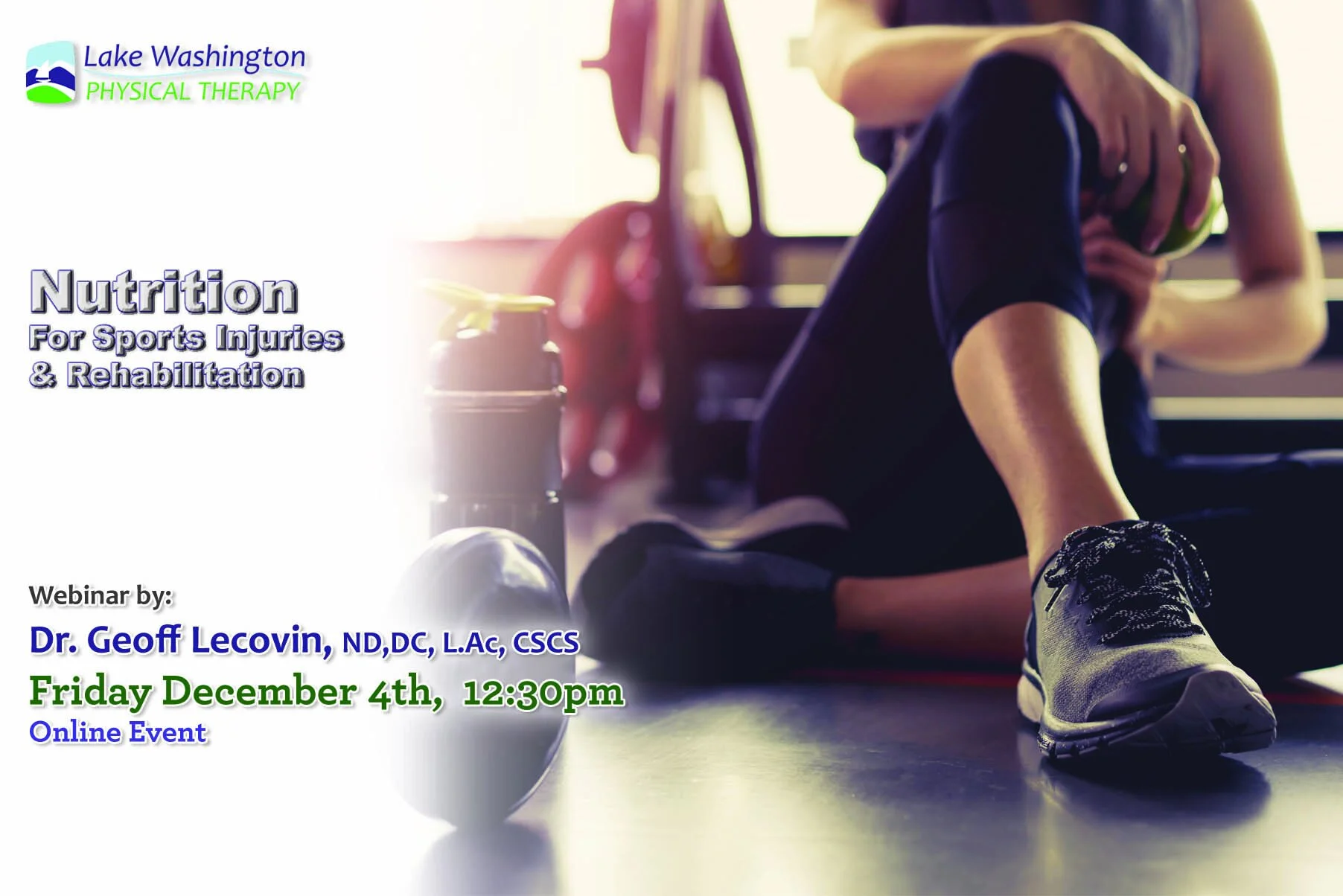Nutrition for Sports Injuries & Healing: 3 of 3
Dr. Geoff Lecovin
MS, DC, ND, L.Ac, CSCS, CISSN
Naturopathic Physician, Chiropractor, Acupuncturist, Nutritionist, & Personal Trainer
“Unleashing the Power of Food”
Dr. Lecovin has up to this point given us a breakdown of all the components that are involved in healing. Now for more specifics on macro nutrients, timing, and specific food types to involve in your performance and recovery.
Specific Nutrient Timing Considerations Include:
Proteins: 20-40g/meal, ideally pulsed every 3-4 hours
Carbohydrates: Meet the total daily carbohydrate needs to support rehabilitation, with the focus on consuming low glycemic carbohydrates before and after rehabilitation
Fats: No specific timing. Include healthy sources with meals
Pre- and post-rehab nutritional interventions: Consume protein and collagen 30-60 minutes prior to rehab exercises
Consume casein protein (~ 30–40 g) at bedtime
Supplements
Supplements can play a role in helping to enhance repair, but only when the foundation (energy, macros, micros and timing) is covered. Supplements can be categorized based on how they support (not block) inflammation as well as their role in muscle, tendon and bone repair.
Inflammation:
Bromelain: Generally about 500 mg 3x/day away from food
Curcumin: 500 mg 3x/day (find product with piperidine)
Fish oil: 2000 mg 3x/day
Muscle Repair:
Adequate Protein
HMB (Beta-hydroxy-beta-methyl butyrate): 3g/day
Fish Oil: 4000 mg/day
Creatine Monohydrate: 5000 mg/day for 5 days (in divided doses), followed by 3000 mg/day
Polyphenols ( micronutrients from plant-based foods ) :
Consume a variety of colorful fruits, vegetables, herbs and
spices
Tendon Repair:
Collagen or gelatin: (SEE BAR PROTOCOL)
Whey Protein: 20-40 g/day (about 3-5 g Leucine)
Nitrates: From food (e.g. beets and chard)- increases circulation
Citrulline Malate: 6,000 – 8,000 mg/day- increases circulation
Barr’s Gelatin Protocol
15 grams of gelatin + 200-500 mg of vitamin C, 30-60 minutes before workout
Workouts should not exceed ten minutes, and be at least six hours before or after other exercise
For rehab after an acute injury, start as soon as possible and do up to three mini workouts per day, separated by six hours
Tendon:
Use isometric holds- 30 seconds, 3-5 times with 30-second breaks
Bone:
Jarring impulses to trigger bone remodeling- Six minutes of jumping rope
Bone Repair:
Adequate Protein and Carbohydrates
Calcium: Aim for 1200 mg mostly from food sources
Vitamin D: Per blood work (optimal levels are 40–60ng/mL)
Hydration
Water is a carrier for nutrients and waste products to and from cells and is a major component of blood. Poor hydration reduces the body's blood volume, thereby reducing oxygen and nutrient delivery, ultimately impairing wound healing. The Institute of Medicine of the National Academies recommends as a baseline that women consume an average of ~90 oz and men consume 125 oz of water per day. Urine color (dark vs light) is one way to monitor hydration status.
Summary
Avoid energy restriction as this will slow down wound healing and exacerbate muscle loss
Eat a well balanced high quality diet to help avoid macro and micro nutrient deficiencies
Optimise protein intake (20-40 g every 3-4 waking hours)
Periodize carbohydrates around exercise/rehabilitation
Consume healthy fats from omega 3 and monounsaturated sources
Choose supplements to support injury healing and repair, opting for a food first approach when possible
The Healthy Plate can be used as a Guide to Balanced Eating
Choose grass-fed, pasture-raised or wild meats/seafood and local and organic produce whenever possible. The freshness and quality of food, and whether that food has been treated with hormones, antibiotics and/or herbicides, can impact the effect of foods on inflammation and health.
References:
Areestion during prolta, J. L., Burke, L. M., Ross, M. L., Camera, D. M., West, D. W., Broad, E. M., ... & Hawley, J. A. (2013).
Timing and distribution of protein ingonged recovery from resistance exercise alters myofibrillar protein synthesis. The Journal of physiology , 591 (9), 2319-2331 Louise M. Burke, John A. Hawley, Stephen H. S. Wong & Asker E. Jeukendrup (2011)
Carbohydrates for training and competition, Journal of Sports Sciences, 29:sup1, S17-S27, DOI: 10.1080/02640414.2011.585473 Clifford, T., Bell, O., West, D. J., Howatson, G., & Stevenson, E. J. (2016).
The effects of beetroot juice supplementation on indices of muscle damage following eccentric exercise. European journal of applied physiology , 116 (2), 353-362. Close, G. L., Sale, C., Baar, K., & Bermon, S. (2019).
Nutrition for the prevention and treatment of injuries in track and field athletes. International journal of sport nutrition and exercise metabolism , 29 (2), 189-197 Currell , Kevin. Performance Nutrition . Crowood Press (April 1, 2017)
Farup, J., Rahbek, S. K., Knudsen, I. S., de Paoli, F., Mackey, A. L., & Vissing, K. (2014). Whey protein supplementation accelerates satellite cell proliferation during recovery from eccentric exercise. Amino Acids , 46 (11), 2503-2516 Frankenfield, D. (2006).
Energy expenditure and protein requirements after traumatic injury. Nutrition in Clinical Practice , 21 (5), 430-437 Glover, E. I., Phillips, S. M., Oates, B. R., Tang, J. E., Tarnopolsky, M. A., Selby, A., ... & Rennie, M. J. (2008).
Immobilization induces anabolic resistance in human myofibrillar protein synthesis with low and high dose amino acid infusion. The Journal of physiology , 586 (24), 6049-6061 Guo, S., & Dipietro, L. A. (2010).
Factors affecting wound healing. Journal of dental research , 89 (3), 219–229. https://doi.org/10.1177/0022034509359125 Juhasz, I., Kopkane, J. P., Hajdu, P., Szalay, G., Kopper, B., & Tihanyi, J. (2018).
Creatine Supplementation Supports the Rehabilitation of Adolescent Fin Swimmers in Tendon Overuse Injury Cases. Journal of sports science & medicine , 17 (2), 279–288 Kelley, D. S., Adkins, Y., & Laugero, K. D. (2018).
A Review of the Health Benefits of Cherries. Nutrients , 10 (3), 368. https://doi.org/10.3390/nu10030368 Kerksick, C. M., Arent, S., Schoenfeld, B. J., Stout, J. R., Campbell, B., Wilborn, C. D., Taylor, L., Kalman, D., Smith-Ryan, A. E., Kreider, R. B., Willoughby, D., Arciero, P. J., VanDusseldorp, T. A., Ormsbee, M. J., Wildman, R., Greenwood, M., Ziegenfuss, T. N., Aragon, A. A., & Antonio, J. (2017).
International society of sports nutrition position stand: nutrient timing. Journal of the International Society of Sports Nutrition , 14 , 33. https://doi.org/10.1186/s12970-017-0189-4 Laumonier, T., & Menetrey, J. (2016).
Muscle injuries and strategies for improving their repair. Journal of experimental orthopaedics , 3 (1), 15. https://doi.org/10.1186/s40634-016-0051-7 Logue, D. M., Madigan, S. M., Melin, A., Delahunt, E., Heinen, M., Donnell, S. M., & Corish, C. A. (2020). Low Energy Availability in Athletes 2020:
An Updated Narrative Review of Prevalence, Risk, Within-Day Energy Balance, Knowledge, and Impact on Sports Performance. Nutrients , 12 (3), 835. https://doi.org/10.3390/nu12030835 Phillips, C. M., Chen, L. W., Heude, B., Bernard, J. Y., Harvey, N. C., Duijts, L., ... & Shivappa, N. (2019).
Dietary inflammatory index and non-communicable disease risk: a narrative review. Nutrients , 11 (8), 1873. Maughan, R. J., Burke, L. M., Dvorak, J., Larson-Meyer, D. E., Peeling, P., Phillips, S. M., ... & Meeusen, R. (2018).
IOC consensus statement: dietary supplements and the high-performance athlete. International journal of sport nutrition and exercise metabolism , 28 (2), 104-125 Myer, G. D., Kushner, A. M., Brent, J. L., Schoenfeld, B. J., Hugentobler, J., Lloyd, R. S., Vermeil, A., Chu, D. A., Harbin, J., & McGill, S. M. (2014).
The back squat: A proposed assessment of functional deficits and technical factors that limit performance. Strength and conditioning journal , 36 (6), 4–27. https://doi.org/10.1519/SSC.0000000000000103 Mountjoy, M., Sundgot-Borgen, J., Burke, L., Carter, S., Constantini, N., Lebrun, C., ... & Ljungqvist, A. (2014).
The IOC consensus statement: beyond the female athlete triad—Relative Energy Deficiency in Sport (RED-S). Br J Sports Med , 48 (7), 491-497 Pence, B. D., & Woods, J. A. (2014). Exercise, obesity, and cutaneous wound healing: evidence from rodent and human studies. Advances in wound care , 3 (1), 71-79. Quintero, K. J., de Sá Resende, A., Leite, G. S. F., & Junior, A. H. L. (2018).
An overview of nutritional strategies for recovery process in sports-related muscle injuries. Nutrire , 43 (1), 27 Sale, C., & Elliott-Sale, K. J. (2019). Nutrition and athlete bone health. Sports Medicine , 1-13 Shaw, G., Lee-Barthel, A., Ross, M. L., Wang, B., & Baar, K. (2017).
Vitamin C–enriched gelatin supplementation before intermittent activity augments collagen synthesis. The American journal of clinical nutrition , 105 (1), 136-143 Smith, Stephen, MSc, PHd, (Cand), NUTRITION FOR INJURY PREVENTION & REHABILITATION applied in an elite powerlifter.2019.
IOPN Performance Nutrition DiplomaTipton, K. D. (2015).
Nutritional support for exercise-induced injuries. Sports Medicine , 45 (1), 93-104 Van Vliet, S., Shy, E. L., Abou Sawan, S., Beals, J. W., West, D. W., Skinner, S. K., ... & Moore, D. R. (2017).
Consumption of whole eggs promotes greater stimulation of postexercise muscle protein synthesis than consumption of isonitrogenous amounts of egg whites in young men. The American journal of clinical nutrition , 106 (6), 1401-1412 Wall, B. T., Snijders, T., Senden, J. M., Ottenbros, C. L., Gijsen, A. P., Verdijk, L. B., & van Loon, L. J. (2013). Disuse impairs the muscle protein synthetic response to protein ingestion in healthy men. The Journal of Clinical Endocrinology & Metabolism , 98 (12), 4872-4881 Yang, D. F., Shen, Y. L., Wu, C., Huang, Y. S., Lee, P. Y., Er, N.X., ... & Tung, Y. T. (2019).
Sleep deprivation reduces the recovery of muscle injury induced by high-intensity exercise in a mouse model. Life sciences , 235 , 116835 Precision Nutrition, Nutrition for Injury Recovery Infographic. https://www.precisionnutrition.com/ http://www.sportsrd.org/wp-content/uploads/2016/08/Nutrition- Support-for-Inury-Recovery-Return-to-Play.pdf
Questions and Contact Info: www.drgeofflecovin.com or email: geoff@drgeofflecovin.com



